|
Boletín de la Sociedad Geológica Mexicana Volumen 74, núm. 1, A081121, 2022 http://dx.doi.org/10.18268/BSGM2022v74n1a081121
|
 |
Organic geochemistry of Paleogene Pabdeh Formation in northern Dezful embayment, Zagros, SW Iran
Geoquímica orgánica de la Formación Pabdeh del Paleógeno en el norte de la bahía Dezful, Zagros, SW Irán
Nazanin Mahmoudzadeh1, Farajollah Fardoust1, Reza Ghavami Riabi2, Mahdi Jafarzadeh1,*
1 Shahrood University of Technology, Faculty of Earth Sciences, P.O. Box: 3619995161, Shahrood, Iran.
2 Shahrood University of Technology, School of Mining, Petroleum and Geophysics, P.O. Box: 3619995161, Shahrood, Iran.
* Corresponding author: (M. Jafarzadeh) This email address is being protected from spambots. You need JavaScript enabled to view it.
How to cite this article:
Mahmoudzadeh,N., Fardoust, F., Ghavami Riabi, R., Jafarzadeh, M., 2022, Organic geochemistry of Paleogene Pabdeh Formation in Northern Dezful Embayment, Zagros, SW Iran: Boletín de la Sociedad Geológica Mexicana, 74 (1), A081121. http://dx.doi.org/10.18268/BSGM2022v74n1a081121
ABSTRACT
In this paper, the organic geochemistry of Upper Eocene-Oligocene Pabdeh Formation, in northern Dezful Embayment, SW Iran, was studied using combination of geochemical measurements including Rock-Eval pyrolysis, Gas Chromatography and Gas Chromatography-Mass Spectrometry. A total of 14 shale samples of Pabdeh Formation were obtained from 14 wells in 11 oil fields in Dezful Embayment. The results show that most of the analyzed samples of the Pabdeh Formation have total organic carbon (TOC) content more than one percent. High TOC values and low volatile hydrocarbons (S1) content in the analyzed samples indicate that the hydrocarbons are autochthonous. On the basis of the plot of S1+S2 versus TOC, the Pabdeh Formation can be classified as fair to excellent source rock. Based on the binary plot of HI against OI, kerogen in the Pabdeh Formation belongs to type II. In terms of maturity, the pyrolysis results also show that, the studied Pabdeh samples are in the immature and early mature stages.A comparison of the obtained data with the previous data on Pabdeh Formation in the southern parts of Dezful Embayment shows the difference in the characteristics of this formation so that in the southern parts the average TOC is less and kerogen type II and III have been reported. GC and GC-MS data confirm the presence of predominantly marine organic matter and less continental input. These results also show that the maturity of samples of Pabdeh Formation is more than what was determined by pyrolysis results.
Keywords: Source rock evaluation, organic geochemistry, Pabdeh Formation, Dezful Embayment, Zagros.
RESUMEN
En este artículo, se estudió la geoquímica orgánica de la Formación Pabdeh del Eoceno superior-Oligoceno, en la bahía norte de Dezful, suroeste de Irán, utilizando una combinación de mediciones geoquímicas que incluyen pirólisis Rock-Eval, cromatografía de gases acoplada a espectrometría de masas. Se obtuvieron un total de 14 muestras de shale de la Formación Pabdeh de 14 pozos distribuidos en 11 campos petroleros en Dezful. Los resultados muestran que la mayoría de las muestras analizadas de la Formación Pabdeh tienen un contenido de Carbono Orgánico Total (COT) superior 1%. También hay altos valores de COT y bajo contenido de hidrocarburos volátiles (S1) en las muestras analizadas los cuales indican que los hidrocarburos son autóctonos. Sobre la base del gráfico de S1+S2 versus COT, la Formación Pabdeh puede clasificarse como roca generadora de regular a excelente. Con base en la gráfica binaria de HI contra OI, el kerógeno en la Formación Pabdeh pertenece al tipo II. En términos de madurez, los resultados de la pirólisis también evidencian que las muestras de Pabdeh estudiadas se encuentran en la etapa inmadura y madura temprana. La comparación de los datos obtenidos y los datos anteriores sobre la Formación Pabdeh en las partes del sur de Dezful Embayment se distingue la diferencia en las características de esta formación, de modo que en las partes del sur el COT promedio es menor y se ha encontrado querógeno tipo II y III. Los datos de GC y GC-MS confirman una predominantemente existencia de materia orgánica marina y una menor presencia continental. Estos resultados identifican que la madurez de las muestras de la Formación Pabdeh es mayor que la determinada por los resultados de la pirólisis.
Palabras clave: Evaluación de roca generadora, geoquímica orgánica, Formación Pabdeh, bahía Dezful, Zagros.
- Introduction
Determining the hydrocarbon generation potential; indicative of the present day kerogen type and an indication of thermal maturity of organic rich deposits, are the main applications of organic geochemistry (Waples, 1985; Bordenave, 1993; Peters et al., 2005; Evenick, 2016). The source rock is a fine-grained sedimentary rock rich in organic matter, which after thermal maturation produces hydrocarbons. Different methods of analysis are commonly used to evaluate the hydrocarbon potential. Among them, Rock-Eval pyrolysis is nowadays a very common and inexpensive way to obtain the information needed to evaluate the hydrocarbon potential of sediments (Espitalie et al., 1985). Although Rock-Eval pyrolysis examines the bulk properties of the organic matter rich sediments, Gas Chromatography (GC) determines the distribution of different types of the compound in the bitumen (Peters and Moldowan, 1993).
The Zagros Basin with several potential source rock units is one of the most prolific hydrocarbon basins in the Middle East. The Zagros Fold Belt, characterized by NW–SE trending folds and thrust faults, extends over 2000 km from eastern Turkey and Kurdistan region in northern Iraq to southern Iran (Farzipour-Saein et al., 2009). From a paleogeographic point of view, Zagros Foreland was created during the Cenozoic as a result of the collision between the Arabian and Iranian plates (Farzipour-Saein et al., 2009; Ezampanah et al., 2013). Pabdeh Formation with Upper Eocene to Oligocene age in Zagros Basin is a formation with predominant carbonate lithology and shale-marl interlayers. This Formation is known as the only active hydrocarbon generating Paleogene source rock in the NE parts of the Dezful Embayment while in SW parts of the Dezful Embayment, the main source rock is the Kazhdumi Formation (Alizadeh et al., 2012; Bordenave and Hegre, 2010; Opera et al., 2013; Alizadeh et al., 2020). So far, numerous studies have been carried out on the Pabdeh Formation in terms of studying the characteristics of the source rocks of this formation using Rock Eval Pyrolysis data (Kamali and Rezaee, 2003; Behbahani et al., 2007; Alizadeh et al., 2012; Mashhadi et al., 2015). However, GC and GC-MS analyses have been less used in investigating the hydrocarbon potential of Pabdeh Formation (e.g. Soleimani and Zamani, 2015). The objective of this study was to investigate the hydrocarbon potential and the probability of being the source rock of Paleogene Pabdeh Formation in 14 wells (from 11 oil fields) in the northern Dezful Embayment (Figure 1) by using a combination of Rock Eval Pyrolysis, GC and GC–MS and comparison with some available data from the southern area of Dezful Embayment.
 |
| Figure 1. Location map of the North Dezful oil fields (modified after Sherkati and Letouzey 2004). |
- Geological setting
The NW-SE–trending Zagros Fold-Thrust Belt extends over 1800 km from Turkey to southeastern Iran, and it represents a large segment of the Alpine-Himalayan collisional system. This belt is divided into two provinces from northeast to southeast including the Dezful Embayment and Fars (Alavi, 2007; Lalami et al., 2020). Dezful embayment, which is located in southwestern Iran, is one of the areas that include a thick sedimentary succession from Mesozoic to Cenozoic with high potential for petroleum targets (Ghanadian et al., 2017). The Paleogene-Neogene sedimentary package of this succession is subdivided into different formations. Pabdeh Formation was named for the first time by James and Wind (1965) based on Kuh-e-Pabdeh in the Khuzestan Province. In the provinces of Khuzestan, Lurestan and Fars in the west and south of Iran, the Pabdeh Formation has been studied in different subsurface and surface sections (e.g. Alizadeh et al., 2012; Mashhadi et al., 2015; Soleimani and Zamani, 2015). This Formation encompasses the entire Zagros Basin, and contains planktonic fauna throughout the basin (Habibi et al., 2017). Based on the paleontological data, the age of Pabdeh Formation is mainly Paleocene, although in upper parts of the sequence in the Khuzestan Province, Early Miocene fauna has also been observed (Konyuhov and Maleki, 2006; Alizadeh et al., 2012; Habibi et al., 2017). Pabdeh Formation overlies disconformably the Gurpi Formation (Campanian-Maastrichtian) with the dominant shale lithology, and its upper boundary with the Asmari carbonates (Oligo-Miocene) is conformable (Figure 2). The Pabdeh Formation has two informal members called the purple shale member and the Talezang member. The thickness and lithology of the Pabdeh Formation vary significantly in each part of the Zagros basin (Mashhadi et al., 2015). This formation was deposited in anoxic to suboxic conditiond and has significant variations in thickness as well as lithology in each part of the Zagros (Kamali et al., 2006; Alizadeh et al., 2012). Uninterrupted argillaceous sedimentation of Pabdeh Formation in the Dezful Embayment and Fars occurs from Paleocene to Eocene time and in Lurestan province it continued until the Oligocene (Bordenave and Burwood, 1990).
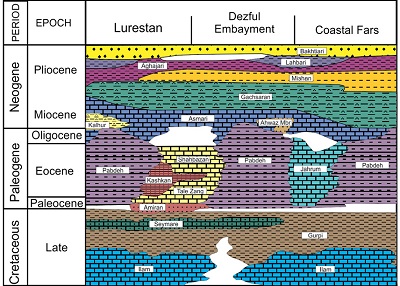 |
| Figure 2. Stratigraphic column of the Lurestan, Dezful Embayment and coastal Fars region (modified after Aldega et al. 2014). |
- Methodology
A total of 14 shale samples from Pabdeh Formation were taken from 14 wells from 11 oil fields in the northern Dezful embayment were selected (Figure 1). The samples were selected from the shaley units of the upper part of Pabdeh Formation. In this study, a combination of different methods including thermal analyses (Rock-Eval pyrolysis), as well as gas chromatography (GC) and gas chromatography-mass spectrometry (GC-MS) data has been used to evaluate organic geochemistry. The major purpose of the Rock-Eval pyrolysis analysis was to obtain information on the following: determination of the organic matter quantity, diversity of kerogens and thermal maturity of organic matter. To achieve this goal, the Rock-Eval 6 pyrolysis technique applied to characterize parameters include S1(volatile hydrocarbons), S2 (remaining hydrocarbon potential) and S3 (amounts of CO2). To obtain these parameters, about 70 to 80mg of pulverized samples were loaded into crucibles, following the standard procedure described by Behar et al. (2001). Additional parameters including Hydrogen Index (HI=S2/TOC×100), Oxygen Index (OI=S3/TOC×100), maximum maturity experienced by source rock (Tmax) and Total Organic Carbon (TOC) were calculated from these measurements and used to evaluate the organic geochemistry and hydrocarbon generating capability of different source rocks (Espitalie et al., 1985; Scheeder et al., 2020). In order to obtain information about biomarkers, samples of Pabdeh Formation were also analyzed by two analytical techniques of gas chromatography (GC) and gas chromatography-mass spectrometry (GC-MS). For Gas Chromatography (GC), an instrument equipped with a 30 m DB-1 fused silica capillary column, was used. For mass spectrometry analysis, the Gas Chromatography was coupled to a Finingan MAT GCQ ion trap mass spectrometer with the oven temperature from 70 to 300 °C (at a rate of 4°C/min) and helium carrier gas.
- Results
Rock-Eval pyrolysis data obtained from studied samples of Pabdeh Formation are presented in Table 1. The TOC contents of 14 studied samples ranged from 0.47% and 7.20%, average TOC content of all samples was 2.24%. The S1 values of the studied samples ranged from 0.45mg HC/g to 5.78 mg HC/g (mean 2.58 mg HC/g; Table 1), and the S2 values ranged from 1.38mg HC/g to 17.1 mg HC/g (mean 6.94 mg HC/g; Table 1). The Tmax values of the shale samples ranged from 426 °C to 439 °C, with an average value of 430 °C. The HI values of the shale samples ranged from 157mg HC/g TOC to 480 mg HC/g TOC (mean 314 mg HC/g TOC; Table 1). The OI values of the studied samples ranged from 14 mg CO2/g TOC to 86 mg CO2/g TOC (mean 48 mg CO2/g TOC; Table 1). The results of gas chromatography (GC) and gas chromatography-mass spectrometry (GC-MS) are also presented in table 2. The ratio of isoprenoids to normal alkanes (Pr/n-C17 and Ph/n-C18) ranged from 0.20 to 0.78 and 0.68 to 3.3, respectively. The 20S/(20S+20R) C29 sterane isomerization in the analyzed samples ranged from 0.11 to 0.62 and ββ/(ββ+αα) C29 sterane isomerization ranged from 0.25 to 0.62. Table 2 also shows that Ts/Tm ratio often varies from 0.27 to 0.59 in the studied samples except for one in the Qaleh nar oil field, where this ratio is 1.22.
| Table 1. Rock-Eval pyrolysis data of the studied samples of Pabdeh Formation from Northern Dezful Embayment. |
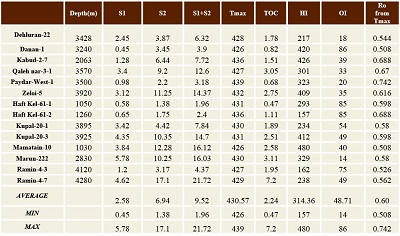 |
| Table 2. Gas Chromatography (GC) and Gas Chromatography-Mass Spectrpmetry (GC-MS) results of the studied samples of Pabdeh Formation from Northern Dezful Embayment. |
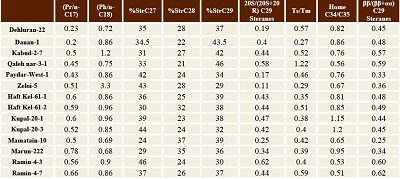 |
- Discussion
5.1. THE USE OF ROCK-EVAL DATA FOR EVALUATION OF SOURCE ROCK
The amount of total organic carbon (TOC) of about 79% of the studied samples of the Pabdeh Formation in the present study (Northern Dezful Embayment) is above 1% (mean 2.24%). This TOC amount is similar to source rocks with medium to very good hydrocarbon potential (Peters, 1986; Peters and Cassa, 1994; Demirel, 2014; Hatampour et al., 2014). Alizadeh et al. (2012) showed that the average of TOC in the Pabdeh Formation samples of southern Dezful embayment was 1.62%, which indicates higher TOC in the northern fields. High TOC values and low S1 content in the studied samples indicate that the hydrocarbons are autochthonous (Figure 3) and also indicate the absence of contamination for the studied samples (Hunt, 1996). Given that obtaining accurate hydrocarbon potential based on TOC data alone is not very reliable, S1 and S2 values obtained from Rock-Eval pyrolysis are used to confirm the hydrocarbon potential interpretation (Peters and Cassa, 1994). According to Rock-Eval pyrolysis results (Table 1), S1 and S2 values confirm that the Pabdeh Formation has hydrocarbon potential ranging from poor to very good. The TOC versus S2 diagram (Peters and Cassa, 1994) shows moderate to very good hydrocarbon potential for the analyzed samples (Figure 4a). The genetic potential of the studied samples (S1 + S2) varies from 1.96 to 21.72 mg HC/g rock. At the same time, the S1+S2 versus TOC diagram also confirms the medium to excellent hydrocarbon potential for the analyzed samples of the North Dezful oil fields (Figure 4b).
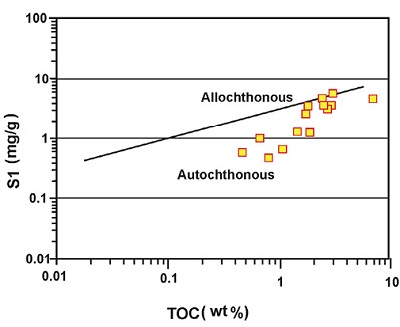 |
| Figure 3. S1 versus TOC diagram to discriminate allochthonous and autochthonous hydrocarbons. |
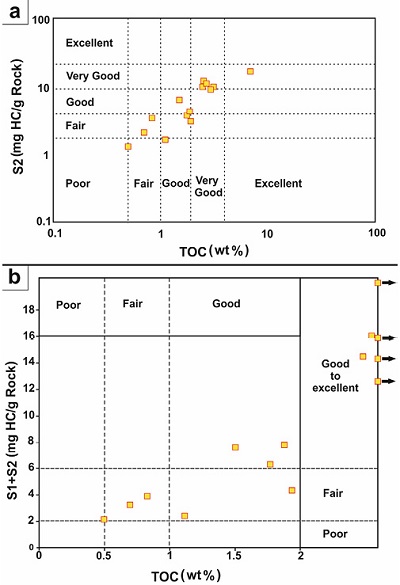 |
| Figure 4. a) S2 versus TOC diagram for the Pabdeh Formation samples, b) Genetic potential (S1+S2) versus TOC diagram for the Pabdeh Formation samples. |
The identification between types of organic matter is usually done by the values of the hydrogen index (HI) (Waples, 1985). According to Waples (1985), a hydrogen index less than 150 mg/g indicates that the organic matter of the sediments contains type III kerogen which has the potential for generation of gas. If the hydrogen index is between 150 and 300 mg/g, it demonstrates the presence of type III and II kerogen and oil and gas production capacity. Eventually, hydrogen indexes more than 300 and 600 mg/g show good to very good oil production potential. The hydrogen index values obtained for the studied samples (Table 1) vary between 157 to 480 mg HC/g TOC. The value of this parameter has been obtained for the samples of Pabdeh Formation in the South Dezful fields between 37 and 575 mg HC/g TOC (Alizadeh et al., 2012). The analyzed samples also show the oxygen index between 14 to 86 mg CO2/g TOC (Table 1). To distinguish the types of kerogens, we have used the diagram of oxygen index versus hydrogen index (Figure 5a). This diagram shows that the kerogen type II was the main component of organic matter constituting the analyzed samples in North Dezful. Meanwhile, Alizadeh et al. (2012) have shown that in the South Dezful, Pabdeh samples have mixed type II/III kerogen.
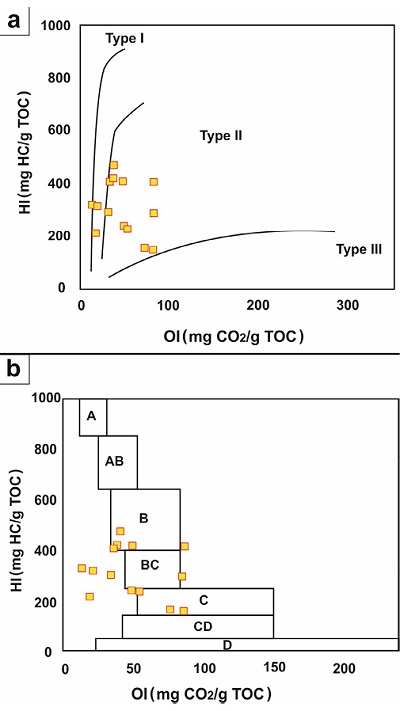 |
| Figure 5. a) Kerogen types of the Pabdeh Formation samples based on plot of HI versus OI. b) Cross plot of HI vs. OI to discriminate the depositional environment of source rocks (Jones 1987). A: Strongly reducing lacustrine environment, AB: Reducing transgressive marine environment, B: relatively reducing lacustrine or marine environment, BC: The environments that consist of terrestrial and marine organic matters together and have a high sedimentation rate in suboxic environment, C: Environments with intermediate sedimentation rate in reducing conditions, CD: Deep environments adjacent to orogeny areas, D: Strongly oxidant continental environments. |
Hydrogen index along with oxygen index can also be used to determine the depositional setting of hydrocarbon sources (Jones, 1987). The algal content of organic matters of sediment decreases from A (strongly reducing lacustrine environment) to D (strongly oxidant continental environments) organic facies and the entry of organic matter from terrestrial and oxidant sources increases (Jones, 1987). Using this diagram (Figure 5b), most of the studied samples are plotted in or near areas B, BC and C of the Pabdeh Formation, which indicates that the analyzed samples were deposited in a mixed (terrestrial-marine) environments with a sedimentation rate of moderate to high and non-oxidant conditions were predominant. In organic geochemistry, the HI versus Tmax plot is also commonly used to estimate thermal maturity of the samples. This plot is also used to differentiate the type of organic matter (Bordenave, 1993). By plotting the data of the studied samples, these samples are generally plotted in the immature to early mature field and type II kerogen (Figure 6a), which confirms the data of the previous plots.
 |
| Figure 6. a) HI versus Tmax diagram for the Pabdeh Formation samples.b) Cross-plot of Pr/n-C17versus Ph/n-C18 for the Pabdeh Formation samples. |
5.2.EVALUATION OF SOURCE ROCK BASED ON GC AND GC-MS DATA
The ratio of isoprenoids such as pristane to phytane is one of the factors in organic geochemistry, based on which the oxidation-reduction conditions in the sedimentation environment of organic matter are studied) (Didyk, 1978; Peters et al., 2005; Mirshahani et al., 2018). Accordingly, if this ratio is less than one in organic matter, it indicates a reducing environment, and if it is more than one, an oxidizing environment. In the studied samples from Pabdeh Formation, the ratio of isoprenoids to normal alkanes (Pr/n-C17 and Ph/n-C18) was calculated, and, based on this; these ratios vary between 0.20 to 0.78 and 0.68 to 3.3, respectively. The plot of Pr/n-C17 versus Ph/n-C18 of the analyzed samples (Figure 6b) shows that these samples are mainly type II kerogen and have an algal-marine origin, deposited in a non-oxidant environment.
The type of organic matter source of analyzed sediments can be obtained based on the relative abundance of regular steranes (C27, C28, and C29) (Peters et al., 2005) using a triangular diagram (Figure 7). This plot shows that most of the analyzed samples have mixed origin of organic matter (58%), and a limited number is in the range of terrestrial plants (14%), and also a small number is in the phytoplankton origin range (28%), which is consistent with B, BC and C fields of Jones (1987), identified from pyrolysis data. The plot of C29 steranes the 20S/(20S+20R) versus ββ/(ββ + αα) is one of the diagrams commonly used to determine the thermal maturity of organic matter because C29 steranes increase with increasing thermal maturity (Peters and Moldowan, 1993; Peters et al., 2005). The values of these two C29 steranes for the studied samples are presented in Table 2. The 20S/(20S+20R) C29 sterane isomerization in the analyzed samples varies from 0.11 to 0.62 and ββ/(ββ+αα) C29 sterane isomerization ranges from 0.25 to 0.62. Based on this plot (Figure 8), most of the analyzed samples are located at the peak of the oil window, two are plotted in the early oil window range, and three are in the immature organic matter field. These three samples are related to Dehluran, Paydar West, and Zeloi oil fields, in the northern sections of the North Dezful Embayment, and have small amounts of organic matter. The difference between the results of this diagram and HI versus Tmax diagram shows that pyrolysis data alone is not enough to examine maturity and biomarker data should also be used.
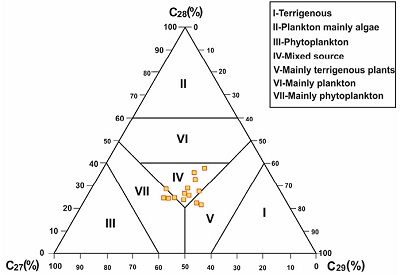 |
| Figure 7. Ternary diagram showing C27, C28 and C29 sterane in samples of the Pabdeh Formation. |
Various parameters of terpenes such as Ts/Tm, C29/C30, and C34/C35 ratios obtained from m/z 191 ion chromatograms are used to separate the depositional settings of sediments containing organic matter (Van Graas, 1990). Accordingly, Ts/Tm and C34/C35 ratios have been used to investigate and determine the sedimentary environment of the samples in this study. Hunt (1996) has shown that the Ts/Tm ratio increases with increasing shale in calcareous facies. Ts/Tm ratios begin to decrease quite late during maturation (Van Graas, 1990). Table 2 shows that this ratio often varies from 0.27 to 0.59 in the studied samples except for one in the Qaleh Nar oil field, where this ratio is 1.22. These values indicate that the samples studied were probably formed in calcareous facies. The C34/C35 ratio less than one indicates relatively reducing marine environments (Mello et al., 1988). Considering the values of this ratio in the studied samples (Table 2), it can be concluded that all samples were formed in a reduced environment.
 |
| Figure 8. The plot of C29 steranes ββ/(ββ+αα) versus C29 steranes 20S/(20S+20R) for determining thermal maturity of Pabdeh Formation samples. |
- Conclusion
The Rock-Eval analyses on the Pabdeh Formation in the North Dezful Embayment revealed that a fair to very good hydrocarbon potential for analyzed samples of the Pabdeh Formation. Hydrogen Index and Oxygen Index values indicate that the Pabdeh Formation samples were deposited in mixed terrestrial and marine environments with high to intermediate sedimentation rates and suboxic conditions. HI against Tmax shows that the studied sediments contain type II kerogens and generally plot in an immature to the early mature zone.
The gas chromatography and gas chromatography–mass spectrometric analyses revealed that organic matter in the studied samples contains mainly mixed materials terrigenous plants and phytoplankton. The ratio of Pr/n-C17 versus Ph/n-C18 for studied samples of Pabdeh Formation shows that all of the samples have algal-marine organic source, the samples are biodegraded and the kerogen of the samples is type II. In terms of maturity, most of the analyzed samples of Pabdeh Formation are in the peak oil window, but two samples are in the early oil window and three samples in the immature field. The Ts/Tm ratios suggest that the studied samples were probably generated from calcareous facies. The C34/C35 ratio from the studied samples shows that studied samples from Pabdeh Formation are mostly generated in reducing environments.
Contributions of authors
Nazanin Mahmoudzadeh: Resources and investigation; Farajollah Fardoust: Investigation,visualization and writing; Reza Ghavami Riabi: Formal analysis, investigation and validation; Mahdi Jafarzadeh: Conceptualization, methodology, investigation, validation, writing – original draft preparation, reviewing and editing.
Acknowledgments
We would like to thank two anonymous reviewers for their constructive critiques. We also would like to extend our appreciation for the efforts of Dr. Alex Correa-Metrio, Co-Editor of the Journal in the course of the review process.
Conflicts of interest
The authors declare that they have no known competing financial interests or personal relationships that could have appeared to influence the work reported in this paper.
References
Alavi, M., 2007, Structures of the Zagros fold-thrust belt in Iran: American Journal of Science, 307, 1064-1095. https://doi.org/10.2475/09.2007.02
Aldega, L., Corrado, S., Carminati, E., Shaban, A., Sherkati, S., 2014, Thermal evolution of the Kuh-e-Asmari and Sim anticlines in the Zagros fold-and-thrust belt: implications for hydrocarbon generation: Marine and Petroleum Geology, 57, 1-13.https://doi.org/10.1016/j.marpetgeo.2014.04.017
Alizadeh, B., Sarafdokht, H., Rajabi, M., Opera, A., Janbaz, M., 2012, Organic geochemistry and petrography of Kazhdumi (Albian–Cenomanian) and Pabdeh (Paleogene) potential source rocks in southern part of the Dezful Embayment, Iran:Organic Geochemistry, 49, 36-46. https://doi.org/10.1016/j.orggeochem.2012.05.004
Alizadeh, B., Opera, A., Kalani, M., Alipour, M., 2020, Source rock and shale oil potential of the Pabdeh Formation (Middle–Late Eocene) in the Dezful Embayment, southwest Iran: Geologica Acta, 18, 1-22. https://doi.org/10.1344/GeologicaActa2020.18.15
Behar, F., Beaumont, V., Penteado, H. D. B, 2001, Rock-Eval 6 technology: performances and developments: Oil & Gas Science and Technology, 56(2), 111-134. https://doi.org/10.2516/ogst: 2001013
Behbahani, R., Khodabakhsh, S., Mohseni, H., Atashmard, Z., 2007, Study of hydrocarbon potential of the pabdeh formation (paleogene)(NW Ilam) based on petrography and geochemistry of organic matter: Research Journal of University of Isfahan, 27,11-26.
Bordenave, M. L., Hegre, J. A., 2010, Current distribution of oil and gas fields in the Zagros Fold Belt of Iran and contiguous offshore as the result of the petroleum systems: Geological Society, London, Special Publications, 330(1), 291-353. https://doi.org/10.1144/SP330.14
Bordenave, M.L., Burwood, R, 1990, Source rock distribution and maturation in the Zagros orogenic belt: provenance of the Asmari and Bangestan reservoir oil accumulations: Organic Geochemistry,16, 369-387. https://doi.org/10.1016/0146-6380(90)90055-5
Bordenave, M.L., 1993, Sedimentation of organic matter, in Bordenave, M. L. (ed.), Applied petroleum geochemistry: Paris, Éditions Technip, 15-76.
Demirel, I.H., 2014, Petroleum Source Rock Assessments of the Upper Permian Strata in the Central Taurus Region of Turkey: Petroleum Science and Technology, 32, 2520-2527. https://doi.org/10.1080/10916466.2013.812115
Didyk, B.M., Simoneit, B.R.T., Brassell, S.C., Eglinton, G., 1978, Organic geochemical indicators of palaeoenvironmental conditions of sedimentation: Nature, 272, 216-222. https://doi.org/10.1038/272216a0
Espitalie, J., Deroo, G., Marquis, F., 1985, Rock-Eval pyrolysis and its applications: Revue de l’Institut Francais du Petrole, 40, 755-784. https://doi.org/10.2516/ogst:1985045
Evenick, J. C. 2016, Evaluating source rock organofacies and paleodepositional environments using bulk rock compositional data and pristane/phytane ratios: Marine and Petroleum Geology, 78, 507-515. https://doi.org/10.1016/j.marpetgeo.2016.10.008
Ezampanah, Y., Sadeghi, A., Jamali, A. M., Adabi, M. H., 2013, Biostratigraphy of the Garau Formation (Berriasian?–lower Cenomanian) in central part of Lurestan zone, northwest of Zagros, Iran: Cretaceous Research, 46, 101-113. https://doi.org/10.1016/j.cretres.2013.06.007.
Farzipour-Saein, A., Yassaghi, A., Sherkati, S., Koyi, H., 2009, Basin evolution of the Lurestan region in the Zagros fold and thrust belt, Iran: Journal of Petroleum Geology, 32, 5-19. https://doi.org/10.1111/j.1747-5457.2009.00432.x
Ghanadian, M., Faghih, A., Fard, I.A., Grasemann, B., Soleimany, B., Maleki, M., 2017, Tectonic constraints for hydrocarbon targets in the Dezful Embayment, Zagros Fold and Thrust Belt, SW Iran: Journal of Petroleum Science and Engineering, 157, 1220-1228. https://doi.org/10.1016/j.petrol.2017.02.004
Habibi, T., Nielsen, J.K., Ponedelnik, A.A., Ruban, D.A., 2017, Palaeogeographical peculiarities of the Pabdeh Formation (Paleogene) in Iran: New evidence of global diversity-determined geological heritage: Journal of African Earth Sciences, 135, 24-33. https://doi.org/10.1016/j.jafrearsci.2017.08.006
Hatampour, A., Razmi, R., Sedaghat, M. H., 2014, Maturity and Source Rock Evaluation of the Gadvan Formation, Persian Gulf, South of Iran: Petroleum Science and Technology, 32, 1948-1956. https://doi.org/10.1080/10916466.2012.723771
Hunt, J.M., 1996, Petroleum Geochemistry and Geology: 2nd ed.: San Francisco, W.H. Freeman, 743 p.
James, G.A., Wynd, J.G., 1965, Stratigraphic nomenclature of Iranian Oil Consortium agreement area: American Association of Petroleum Geologists Bulletin, 49, 2182 - 2245. https://doi.org/10.1306/A663388A-16C0-11D7-8645000102C1865D
Jones, R.W., 1987, Organic Facies, in Brooksand, J., Welte, D. (ed.), Advances in Petroleum Geochemistry: London, Academic Press, 90p.
Kamali, M.R., Rezaee., M.R., 2003, Burial history reconstruction and thermal modelling at Kuh‐e Mond, SW Iran: Journal of Petroleum Geology, 26, 451-464. https://doi.org/10.1111/j.1747-5457.2003.tb00038.x
Kamali, M.R., Fathi Mobarakabad, A., Mohsenian, E., 2006, Petroleum geochemistry and thermal modeling of Pabdeh Formation in Dezful Embayment: Journal of Science Islamic Republic of Iran, 32, 1–11.
Konyuhov, A. I., Maleki, B., 2006, The Persian Gulf Basin: Geological history, sedimentary formations, and petroleum potential: Lithology and Mineral Resources, 41 (4), 344-361. https://doi.org/10.1134/S0024490206040055
Lalami, H. R. K., Hajialibeigi, H., Sherkati, S., Adabi, M. H., 2020, Tectonic evolution of the Zagros foreland basin since Early Cretaceous, SW Iran: Regional tectonic implications from subsidence analysis: Journal of Asian Earth Sciences, 204, 104550. https://doi.org/10.1016/j.jseaes.2020.104550
Mashhadi, Z.S., Rabbani, A.R., Kamali, M.R., 2015, Geochemical characteristics and hydrocarbon generation modeling of the Kazhdumi (Early Cretaceous), Gurpi (Late Cretaceous) and Pabdeh (Paleogene) formations, Iranian sector of the Persian Gulf: Marine and Petroleum Geology, 66, 978-997. https://doi.org/10.1016/j.marpetgeo.2015.08.008
Mello, M.R., Telnaes, N., Gaglianone, P.C., Chicarelli, M.I., Brassell, S.C., Maxwell. J.R., 1988, Organic geochemical characterisation of depositional palaeoenvironments of source rocks and oils in Brazilian marginal basins: Organic Geochemistry, 13, 31-45. https://doi.org/10.1016/0146-6380(88)90023-X
Mirshahani, M., Bahrami, H., Rashidi, M., Tarhandeh, E., Khani, B., 2018, Organic geochemical evaluation of potential Cenozoic source rocks in the Moghan Basin, NW Iran: implications for hydrocarbon exploration: Journal of Petroleum Geology, 41, 393-410. https://doi.org/10.1111/jpg.12709
Peters, K.E., 1986, Guidelines for evaluating petroleum source rock using programmed pyrolysis: American Association of Petroleum Geologists Bulletin, 70, 318–329. https://doi.org/10.1306/94885688-1704-11D7-8645000102C1865D
Peters, K.E., Cassa, M.R., 1994, Applied source rock Geochemistry, in Magoon, L.B., Dow, W.C. (ed.), The petroleum system from source to trap: American Association of Petroleum Geologists Memoir, 60, 93-120.
Peters, K. E., Moldowan, J. M., 1993, The Biomarker Guide- Interpreting Molecular Fossils in Petroleum and Ancient Sediments: Prentice-Hall, Englewood Cliffs, New Jersey, 363 p.
Peters, K. E., Walters, C. C., Moldowan, J. M., 2005, The Biomarker Guide, Volume 2: Biomarkers and Isotopes in the Petroleum Exploration and Earth History: Cambridge University Press, United Kingdom, 704 p.
Scheeder, G., Weniger, P., Blumenberg, M., 2020, Geochemical implications from direct Rock-Eval pyrolysis of petroleum: Organic Geochemistry, 146, 104051. https://doi.org/10.1016/j.orggeochem.2020.104051
Sherkati, S., Letouzey, J., 2004. Variation of structural style and basin evolution in the central Zagros (Izeh zone and Dezful Embayment), Iran: Marine and Petroleum Geology, 21(5), 535-554. https://doi.org/10.1016/j.marpetgeo.2004.01.007
Soleimani, B., Zamani. F., 2015, Preliminary petroleum source rock evaluation of the Asmari–Pabdeh reservoirs, Karanj and Parsi oil fields, Zagros, Iran: Journal of Petroleum Science and Engineering, 134, 97-104. https://doi.org/10.1016/j.petrol.2015.07.016
Van Graas, G.W., 1990, Biomarker maturity parameters for high maturities: calibration of the working range up to the oil/condensate threshold: Organic Geochemistry, 16, 1025-1032. https://doi.org/10.1016/0146-6380(90)90139-Q
Waples, D.W., 1985, Geochemistry in Petroleum Exploration: Human Resources and Development Co, Boston, 232 p.
Manuscript received: May 7, 2021
Corrected manuscript received: September 15, 2021
Manuscript accepted: October 25, 2021
Peer Reviewing under the responsibility of Universidad Nacional Autónoma de México.
This is an open access article under the CC BY-NC-SA license(https://creativecommons.org/licenses/by-nc-sa/4.0/)

